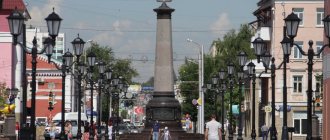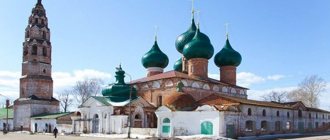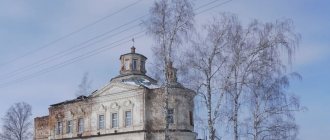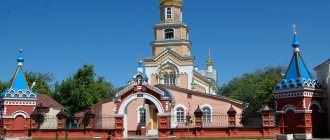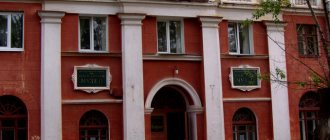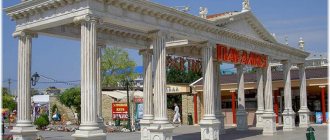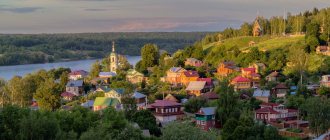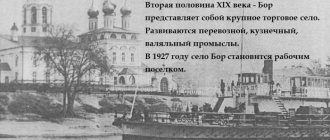Historians suggest that this particular place, where modern Plyos is located, was mentioned back in the “Novgorod Chronicle” in 1141. When the first Plyos fortress was built, scientists are silent, but it is known that the city was destroyed by Batu’s troops in 1238. Status of the district Plyos received the city in 1778. In the modern sense, the settlement began to be called urban in 1925.
Over the centuries-old history, many events have happened here. Many Russian artists lived and worked here. In Plyos there are many museums, ancient churches, and monuments to historical figures. There are no industrial enterprises there. Due to some of its patriarchal nature, natural beauty and abundance of attractions, it attracts tourists and travelers. We will talk about them with photos and descriptions.
What to see in Ples in 1 day – TOP-3
There are not too many attractions in the city, but those that exist deserve attention, that’s for sure. What to see on your own in Plyos first?
Cathedral of the Assumption of the Blessed Virgin Mary
- Address: Sobornaya Gora street.
The building of the Assumption Church is considered the oldest religious site in Plyos. It was built on the site of a wooden cathedral complex damaged by fire. Erected in 1699, the stone church acquired a new altar a century later. At the beginning of the 19th century, a tented bell tower also appeared here.
Somewhat later, in 1824, a chapel was erected near the Holy Assumption Church. Four years later, the Kazan summer temple was built. The money for this was allocated by local tradesman V. Shishkin. The resulting complex was surrounded by a brick fence. A gate was placed on the south side.
According to its architectural style, the religious building is classified as a provincial version of Russian Baroque. The winter part of the ensemble, the Assumption Cathedral, has survived to this day. The gates that were part of the church fence also survived. Restoration work is underway in the church. It is planned to restore not only the building itself, but also its interior decoration.
House-Museum of I. Levitan
- Address: st. Lunacharsky, 4/1.
A memorial dedicated to the outstanding landscape artist was opened in 1972. The museum dedicated to him was located in the former house of the merchant Solodovnikov. Here Levitan lived and worked in 1888-1889. In just three seasons spent in Plyos, the master managed to write about 200 works.
Among the works were 23 paintings, many sketches and sketches. The most significant paintings from the “Plyos period” can be called “Quiet Abode”, “Evening. Golden Reach”, “Above Eternal Peace”.
The museum exhibition includes 3 sections. They talk about the artist’s biography, highlight his life in a town on the Volga, and introduce him to his personal belongings displayed in a separate showcase.
The basis of the museum’s collection of the artist’s works were canvases donated by a collector from Moscow , Felix Vishnevsky. Many exhibits were purchased from private individuals. The museum contains not only Levitan's paintings. Here you can also find works by his friends - A. Stepanov and S. Kuvshinnikova.
Plyos embankment
- Coordinates on the map: 57.460348, 41.518615.
Of course, it simply cannot be ugly on the banks of the Volga. Tourists really like it in Plyos, on its river embankment, as do the residents of the town and region itself. Almost the entire street is literally dotted with ancient houses and mansions, dachas that once hosted distinguished guests.
The Ples embankment also delights those who wish with numerous attractions, in particular, boat trips along the Volga, which are offered almost everywhere. Reviews also indicate that in the local shops you can buy delicious smoked fish, such as bream, excellent pies, and a variety of souvenirs.
How to get there
There are several ways to get to Plyos:
- Bus. A bus departs from Moscow to Plyos every day at 18:00, the route starts from the Shchelkovskaya metro station. You will have to spend a little more than seven hours on the way, the cost of the trip: from 850 rubles. However, it will be more convenient to first get to the city of Ivanovo, and then transfer to a bus to Plyos. There are quite a lot of flights (more than 10), travel time is about two hours, tickets cost from 190 rubles.
- Train. You can only get to Plyos by train from Ufa, Adler and Nizhnevartovsk. From other cities, trains go only to Ivanovo, from which you will need to take a bus.
- Automobile. The most convenient way to get to Plyos is a personal car. Between Moscow and Plyos there is a distance of 350 kilometers, which can be covered in 5 hours. You need to drive either along the Yaroslavl highway or along the Vladimir highway. From the Northern capital the journey will be long - approximately 16 hours. The route will follow the M10 highway or the A114 highway.
Temples and churches of the city of Plyos
Russia is a country where religion has always been treated with special respect, with the exception of Soviet times. Maybe that’s why in any, even the smallest town, there are many holy places. Ples was no exception.
Church of the Resurrection of Christ
- Address: Varvarinskaya st., 19A.
Once upon a time there was a small Church of the Resurrection on Peter and Paul Mountain. It was built in the 17th century. Not far from it there was a graveyard. This temple, which also had another name - “Above Eternal Peace”, was immortalized by I. Levitan.
The church depicted on the artist’s canvas is somewhat different from the modern temple. The thing is that the cathedral, which “posed” for Levitan, burned down in 1903. All that remains about it are memories and a painting by the great Russian painter. A new church was erected on this site only when a museum dedicated to I. Levitan opened.
For this purpose, in 1982, a wooden church was moved from the village of Bilyukovo (in the Ivanovo region). It is made in the same style as the burnt shrine and was built in 1699. Now the mountain, named after the artist, is again decorated with a small but picturesque church, located next to the almost overgrown cemetery.
Church of the Life-Giving Trinity and Vvedensky Church
- Address: st. Kornilova, 9/11.
The Trinity Church of Plyos has been known since 1628. Its “wooden history” lasted 180 years. During this time, a new cathedral was built (also made of wood). In 1778, another temple was erected - Vvedensky. Services could also be held there in winter.
In 1808, a stone building was erected on the site of the Trinity Church. 20 years later, with donations from the Chastukhin merchants, a “warm” stone Vvedenskaya Church was built. These temples, located nearby, are somewhat different in architecture.
The Cathedral of the Life-Giving Trinity belongs to the Baroque style, which has elegant forms and lush decoration. The Vvedensky Church is an example of the Russian Empire style. Its architecture successfully adds color to this cathedral complex.
Church of St. Barbara
- Address: Varvarinskaya st., 19A.
Plyos, located near the banks of the Volga, is difficult to imagine without the Varvara Church. It has been a decoration of the eastern part of the town for many years. There is no reliable information about when this stone temple with snow-white walls appeared. Based on its architectural forms, historians attribute its construction to the 17th century. The wooden church, on the site of which the current Varvara Cathedral was erected, was built much earlier.
Some data say that the local temple bell tower appeared in 1821. A picturesque view of Ples opens from the Volga. The Church of Barbara the Great Martyr complements this beautiful landscape well. The Varvarinsky and Resurrection churches of the city glorify local beauties on the canvases of I. Levitan.
The Church of St. Barbara is made in a simple and ascetic style. But the same cannot be said about the magnificent decoration of the bell tower. The Varvarinsky Cathedral has glue paintings inside. They are paintings on biblical themes. Images telling the story of the life of Jesus Christ are decorated with ornaments characteristic of the Baroque architectural style of this landmark.
Church ensemble of the Resurrection Church and the Cathedral of the Archangel Michael
- Address: st. Lenina, 2.
The Church of the Resurrection of Christ was erected on the western side of the old shopping area. Its creation was made possible thanks to donations from parishioners. Having collected the necessary funds, in 1817 they erected a new stone cathedral with a bell tower. It was dedicated to the heroes of the Patriotic War of 1812.
The Church of the Resurrection has a fence and two altars - the Resurrection and the Nativity of Christ. From the documents of the Kostroma diocese of 1911, where the temple previously belonged, it follows that at the Resurrection Cathedral there was a parochial school and there was a temperance society.
The second building of the temple ensemble is the Church of the Archangel Michael. We are talking about a wooden log house, similar to an ordinary village house. Previously he stood in the village. Antonovo. It was built in 1825. Only a small dome with a cross indicates that it belongs to religious buildings.
Now St. Michael's Church has been moved to Ples. It is located within walking distance from the Church of the Resurrection, forming a single complex. It was installed within the city limits in 1989.
Church of the Transfiguration
- Address: st. Ostrovsky, 24.
The Transfiguration Church, located on a hill near the Volga, adds color to the picturesque landscapes of the small town. It was built in the western part of the settlement in 1849. Previously, the Spaso-Preobrazhensky Monastery was located in these places. It was abolished in 1764.
The current brick cathedral is located next to the cemetery. Its territory is not fenced. It has three altars - the Transfiguration of the Lord (“cold temple”), the Vladimir Icon of the Mother of God and St. Nicholas the Wonderworker (“warm”). Previously, there was a charity home for orphans and a temperance society at the shrine.
The church has a unique architecture. In the mixture of styles, forms of early classicism are visible. Fragments of paintings from previous years have been preserved in the temple dome.
Chapel of St. Nicholas the Wonderworker
- Address: Varvarinskaya st., 1.
The chapel building is a good example of similar religious objects of that time. It was built in the eastern part of Plyos in 1892. This whitewashed brick structure is considered to be in the Russian architectural style.
Nicholas Chapel is an octagonal building. It blends in with the low wooden houses that surround it. The facades are simple and expressive at the same time. The building is crowned with an Orthodox cross. The chapel is currently closed.
All the sights of Plyos: description and photos
Plyos is a small chamber town in the Ivanovo region. But it is rich in sights and interesting places: churches, museums, art galleries, sculptures, houses decorated with wooden carvings and even openwork gutters - all this is worth seeing! The best way to see the city is on foot. And don’t let the hilly landscape scare you, walking around Ples is pleasant and easy.
So let's begin!
The descent from the house-hotel "Volga-Volga" leads us to the bridge over the river. Shokhonka, we cross the river and along the street. Nikolskaya we are moving towards the Volga.
You should definitely stop at house number 20 on this street. Here is the Provincial ART Gallery-M. This private museum presents: USSR porcelain, Western European porcelain in the “nude” style, large-figure faience “Konakovo factory”, Russian varnishes, a gallery of paintings by V.A. Fedorov, Russian majolica, Leniniana, portraits of the 20th century. Founder of the gallery Marushkin Yu.B. will lead an interesting excursion. You will not regret!
Near the gallery, an artist sat on logs, looking into the distance. This is a monument to the Honored Artist of the RSFSR, famous landscape painter, native of Ivanovo-Voznesensk, Vyacheslav Fedorov.
Opposite the gallery, a small street goes slightly uphill. Having taken a few steps along it, you can see the sculpture of the Policeman, a guard, respectfully awaiting the arrival of the owner or his guests and keeping order in the area.
The next house (number 18) on Nikolskaya Street is the Gallery of the artist L. Nikolaev “Painting and Graphics”. The landscapes of this painter are interesting for their romantic vision of nature, freedom of plastic expression, complexity, softness and integrity of the color structure of the sheet.
Continuing our descent to the Volga, at the intersection with Varvarinskaya Street we see the St. Nicholas Chapel, built in 1892. It is a classic example of chapels in central Russia. Currently not operational.
And here we are on the banks of Mother Volga!
On the left there is a monument to I.I. Levitan, the famous Russian artist, master of “mood landscape”. Fascinated by Plyos, Levitan spent the summer of 1888 here, and then came here for two more subsequent seasons.
Opposite the monument is the house-museum of I.I. Levitan. The museum's exhibition includes two halls: the first is dedicated to the creative biography of the artist, the second houses original works by I.I. Levitan and his friends. On the mezzanine there is a room where the artist and his friends lived.
Passing by the house-museum of I.I. Levitan and moving to the right along the embankment, we reach the Levitan Cultural Center or Levitan Hall. Film screenings, conferences, seminars, concerts and many other cultural events are held here.
Further along the embankment (Lunacharskogo St., 20) is the only landscape museum in Russia. Exhibitions of contemporary landscape painting from Russian regions, the Plyossky Plein Air festival and the Volga Artist children's plein air exhibition are regularly held here.
Opposite the museum, a young girl “Summer Resident” is sitting on a bench. It is assumed that the prototype of this sculpture was the companion of I.I. Levitana, artist S.P. Kuvshinnikova.
Another interesting sculpture can be seen by walking further along the embankment, past the city beach to the “My Pier” house-pier. This is a sculpture of the Boatswain, a figure of a riverman similar to Captain Vrungel.
Not far from Botsman, near the Itil hotel, there is the Zelenya Old Believer cemetery, established at the end of the 17th century. Now it is closed, and only small overgrown hills remind that there was a cemetery here.
Returning to the Landscape Museum and going up a small street up from the Volga, we see the Church of Barbara the Great Martyr. The construction of the temple dates back to the beginning of the 18th century, and the current bell tower was built in 1821. This church is depicted in the painting by I.I. Levitan "Evening. Zolotoy Plyos".
Behind the Varvarinskaya Church, Kirova Street goes up. Having climbed it, we find ourselves at the beginning of the Levitan trail, a wooden staircase 168 steps long. Climbing the stairs is not difficult: there are several rest areas with comfortable benches.
Having overcome all the steps, we find ourselves on Mount Levitan.
There is a whole sculptural complex installed here, opened several years ago. It includes a bronze sculpture of the artist standing in front of an easel, as well as (a little further away) a copy of the artist’s work “Above Eternal Peace” in a bronze frame.
On Mount Levitan, behind a small fence, there is the Resurrection Wooden Church. This is a wooden cage church (1699), erected on the site of the burnt cemetery church of Peter and Paul. The lost church is depicted on the canvas by I.I. Levitan "Above Eternal Peace".
A worship cross was erected in memory of all those buried in this ancient cemetery.
Having walked around the entire Levitan Mountain, along Vichugsky Passage you can go down to the bridge over Shokhonka. If your energy is running low, be sure to stop by the Volga-Volga house-hotel and drink a cup of invigorating tea or coffee on the open veranda.
Strength restored!
Now our path lies to Cathedral Mountain (height 54 m above sea level). We go up the street Descent of Mount Liberty.
In house number 1a there is the P. Travkin Archaeological Museum. Here you can take a short trip into the distant past, here each item is reproduced reliably, based on archaeological data.
We are at the top of the mountain. From here the city began to grow. Prince Vasily I, the son of Dmitry Donskoy, in 1410 ordered the foundation of a defensive fortress here. The river in this place flows along a straight stretch of almost 2 km. And all approaches to the city are clearly visible.
Fortress walls, a rampart and a moat were built. Unfortunately, the fortress walls and moat have not survived. And fragments of the fortress rampart can be seen from the side opposite to the Volga.
From the fortress rampart there is a view of the Trinity Settlement, located at the entrance to the city, and of the temple complex, consisting of two churches: the Winter Vvedenskaya and the Summer Trinity. The Vvedenskaya Church was first made of wood, and in 1828 it was built of stone. Adjacent to the temple is a long, low refectory. Trinity Church was also built first in wood in 1628, and in 1808 in stone.
In the center of Cathedral Hill is the Assumption Cathedral. This is the oldest temple in the city (1699), it still operates in our time and amazes guests of the city with its “crimson” bell ringing.
Behind the cathedral we see a monument to Prince Vasily I. The installation of the monument in 1910 became a serious event for the city: even the capital’s newspapers wrote about the celebration that took place in a small provincial town.
Next to the monument there is an exhibition complex “Public Places”. The permanent exhibition of the exhibition complex is dedicated to the historical development of Plyos. Other exhibitions are changing, usually timed to coincide with events in the cultural life of the city.
In the Public Places there is an unusual exhibit, the Stone of Love, which got its name due to its unusual shape.
A birch alley winds along the perimeter of Cathedral Hill. The age of birches reaches 150 years. This is a very popular place for walking for both local residents and visitors to the city.
At several points on the top of the mountain there are observation decks and comfortable gazebos where you can hide from the sun and rain.
Having completed the inspection of Cathedral Mountain, we go down the rocky street, where even on a hot afternoon it is cool and comfortable. Trees growing along the path provide protection from the heat. We turn left...
And here we are at Trade Square. This is the central (and only) square of the city. Since ancient times, lively trade took place here and fairs were held. Now there are shops with souvenirs for every taste.
At the intersection of the street. Yuryevskaya stands with the fire department building, built in 1885. The fire station was located on the first floor, the police station and prison cells were on the second.
In the eastern part of the square, at the intersection with the street. Lenin stands the Chapel of the Archangel Michael. This wooden “cage” chapel was brought from the village of Antonovo in the 1980s. and restored.
Opposite the chapel, the Church of the Resurrection of Christ is majestically located. The church was built in 1817 on the site of two wooden churches. They decided to replace the old churches with new ones in memory of the victory of the Russian people in the Patriotic War of 1812.
On the opposite side of the square from the Resurrection Church we see the entrance to Kalashnaya Street, the oldest shopping street in Plyos, the first mention of which dates back to 1787.
Going down from Torgovaya Square, we go out to the Volga embankment. To the right along the embankment are ancient mansions built from the late 18th to the mid-19th centuries. Almost each of the mansions belonged to some famous family in Plyos and has since then been named after them.
Turning left from Torgovaya Square, we find ourselves on Plyossky Vernissage, the alley of artists. In the summer, here you can view and purchase works by Plyos artists and products by masters of applied art. In winter, snow figure competitions are held on the alley.
Here on the embankment there are Meat (lower) shopping arcades and the Vekshina teahouse. The house was built in the second quarter of the 19th century. in the style of provincial classicism. On the ground floor there was a large hall of the Vekshin teahouse.
We recommend visiting the exhibition “Art Crafts of the Ivanovo Region” in the building of “Flour Rows”. You can see examples of jewelry, linen jacquard weaving, lacquer miniatures, as well as original Ivanovo embroidery.
A little further along the embankment (Sovetskaya St., 49) there is a private gallery “Exhibition Hall on the Embankment”. The works of artists of the Ivanovo region, including Plyos artists, are presented here.
Don’t be too lazy to walk along the embankment. On the street Lenina, 26 (entrance from the embankment) you will see the art studio of Vitaly Panchenko. Vitaly Panchenko is a Russian artist, a member of the Creative Union of Artists of Russia, one of the founders of the creative organization “Community of Plyos Artists”.
Opposite the art studio, almost right next to the water, there is a stone, and on the stone is a cat, constantly looking at the Volga. The monument was erected in honor of the cat Mukha (the owners are the Plyos artist V. Panchenko and his wife Galina). A cat died protecting her kittens from angry dogs.
Ostrovsky Street goes up a little from Koshka. After walking along it, you will come to the Church of the Transfiguration. This cemetery church (1849) was built in the classicist style on the site of the Transfiguration Monastery through the diligence of benefactors.
In the city of Ples there is another mountain, Voskresenskaya. There is a memorial to the soldiers who died in the Great Patriotic War.
- Plyos artistic
- Ples - a pearl on the Volga
Plyos Fortress
- Address: st. Nikanorka.
The emergence of a settlement on the site of modern Plyos dates back to the 12th century. Cathedral Hill, where the city is located, is of strategic importance. Ships passing along the Volga slow down here, the river bed bends and becomes impassable for ships.
At the confluence of the great Russian river and its tributary Shokhonka, several fortresses were built.
All that is known about the first of them is that it was burned by the troops of Batu Khan in 1238. The defensive structure was re-erected during the reign of Vasily I, in 1410. The fortress became not only a defense of the Kostroma and Moscow lands. It was also used as a customs house on the Volga borders. The fortification was destroyed by the Kazan Tatars after defeating the garrison of the Plyos fortress. This happened in 1429.
The partially restored wooden buildings of the fortress fell into complete disrepair by the 17th century. It is possible that some structures that previously protected the borders of the Vladimir-Suzdal principality, Kostroma and the capital of ancient Russia were completely destroyed during the Polish-Lithuanian invasion in 1609.
After these events, no new fortifications were built. Currently, the earthen rampart and moat have been preserved.
Watch tower
Research work began on the site of the Plyos fortress in 1959. Much later (in 1990), scientists received information about the structure of the defensive walls and towers of the fortress. They had their own characteristics. It is believed that during the construction of fortifications, not only logs were used, but also brick and boulder stone.
Having thoroughly studied the construction technology of that time, restorers managed to recreate one of the watchtowers of that time. It is adjacent to log walls. The space between the outer and second, inner, walls is covered with cobblestones. Interestingly, the fortress was one of the first designed for protection against firearms.
Nowadays excursions are conducted to the former walls of the Plyos fortress and its watchtower. Looking at the beautiful Volga from the heights of Cathedral Mountain, you understand why the city received such a name.
State Historical-Architectural and Art Museum-Reserve
- Address: st. Cathedral Mountain, 1.
This is the name given to the museum complex created in 1982. Several cultural institutions were united under a common name, including the already described Levitan House-Museum. Thanks to the creation of the museum-reserve, it was possible to preserve the natural beauty and uniqueness of a small town on the Volga, as well as its historical attractions.
Landscape Museum
- Address: st. Lunacharsky, 20.
The second museum of the historical and artistic complex of Plyos is located in a house from the late 18th century. This is a former merchant mansion. It is considered the oldest building in the lower part of the city. Despite its age, it is in good condition.
The cultural institution opened within these walls in 1997. It became the first in Russia to tell the history of the development of landscape painting in the country.
The permanent exhibition presents works by artists of the 19th-20th centuries. There are authentic landscapes by I. Shishkin, V. Polenov, I. Levitan, A. Savrasov and other equally famous masters of painting.
In addition to visiting the permanent exhibition, you can also visit temporary exhibitions in the museum. The complex welcomes not only domestic lovers of landscape painting. Foreign guests are also common here. Museum tours will delight any visitor - from the inexperienced beginner to the most demanding professional.
Exposition “Artistic crafts of the Ivanovo region”
- Address: Sovetskaya st., 41.
The house where the Museum of Arts and Crafts has been located since 2008 is an architectural monument. This 19th-century structure once housed the city's Flour Rows.
The cultural center presents the best works of masters of the Ivanovo region. The museum has two exhibition halls. They contain works by Palekh and Kholui (lacquer miniatures). The exhibits belong to miniature artists who worked in the 70-90s. last century.
The central place in the eastern hall is occupied by a furniture set. Based on folk tales, it was painted by the artist A. Kurkin.
In the western hall, the main exhibit is an antique jacquard loom from the 19th century. Using this machine it was possible to create complex patterns from intertwined threads. A curtain created using such equipment is presented as a sample of how the machine works.
A separate showcase is dedicated to products from the Yakovlevskaya manufactory. Its products (snow-white tablecloths, napkins and towels) are known not only to local residents.
The art salon, located in the museum foyer, invites visitors to purchase works of masters. Here you can find artistic embroidery, lacquer miniatures, ceramics, and silk paintings. All products presented by the salon are original works.
Museum and exhibition complex "Public Places"
- Address: Sobornaya Gora, 1.
A museum with such a name, it would seem, should tell visitors about these very “public places.” But this is somewhat different. Rather, it is a historical and archaeological museum. There are excursions here that introduce the events of bygone years.
The cultural center received its name, most likely, because the City Government and the City Public Bank (public places) were once located in the building. In addition to these institutions, the Higher Primary School for Men was located in the house built in 1786.
Today the museum has a permanent exhibition that introduces visitors to the history of Plyos. The excursion program will help you learn about the life of the first people who began to inhabit these places. The collection contains many archaeological finds and historical artifacts. Here you can see unique women's jewelry from the Alabuga Treasure. Historians date the find to the 7th century.
The museum also contains cult stones. They were also used by pagans when performing their rituals. The permanent exhibition of the museum covers the period up to the beginning of the 17th century. Temporary exhibitions of the cultural center tell about the later history of these places.
In addition to museums, urban planning monuments also belong to the historical and architectural reserve. Most of the buildings of historical value are merchant mansions. Many of them were built in the 19th century. The reserve also manages several religious sites in the city.
Tips for tourists
You can come to Plyos at any time of the year. There is an influx of tourists both in summer and winter. If in the warm season people come here to admire the beauty of the local nature and explore the sights, then in winter ski lovers come here.
There is a whole ski complex on Milaya Gora. It consists of seven tracks. There are both difficult and children's routes here. Equipment can be rented, and the complex also has trainers who can teach skiing or snowboarding.
The complex is equipped with everything you need: a ski lift, various trails, parking, shops and guest houses
Ski resort address: Milovka village.
All the main attractions of the town can be easily explored in one day, so there is no point in checking into a hotel. Although there are quite a lot of them in Plyos. Approximate route:
- You should start exploring the city from Cathedral Hill, where the monument to the founder of the city, the Assumption Cathedral and public places are located.
- Next, you should explore the religious architecture of the city. Then, walking along the embankment, you can see old mansions, sculptures and get to the Levitan house-museum. There are also two more churches nearby, as well as the Landscape Museum.
- Then you should go to the Descent of Mount Freedom to explore the exhibitions in the Wedding Museum and in the “Russian Izba”.
- The next point will be the Glass Museum, and you can complete the journey on Kalashnaya Street. There you can buy souvenirs for your loved ones.
You can visit all the most popular tourist spots in Plyos in one day
What to bring as a souvenir
In Plyos you can find standard souvenirs, but there are also more interesting things here - items made by the hands of local craftsmen:
- linen items;
- amulets;
- ceramic dishes and figurines;
- rag dolls;
- silver jewelry.
Artists love to come to Plyos to depict local beauties on their canvases;
masters often sell their works immediately after painting. The most popular gifts from Plyos are paintings by local artists depicting landscapes of Plyos.
Other interesting museums in Plyos
In addition to the main museum complex, the city has several other small cultural centers.
Russian House Museum
- Address: st. Freedom Mountain Descent, 1.
This museum center combines two historical eras. Its exhibition is a combination of a medieval estate with a house where a Plyos family lived in the 19th century.
Here we managed to recreate the atmosphere of the Middle Ages. In the “living museum” you can try to grind grain on an old grain grinder, work on a potter’s wheel, and try on clothes of that time. Of course, these are copies of ancient objects, but they also show visitors how the people who inhabited these places lived in the Middle Ages.
There are no display windows or warning signs in the estate. Everything here is arranged as it was before. The courtyard is divided into male and female parts by wooden pavement. The master's part of the house is occupied by a jeweler's workshop, in the corner there is a warrior's armor - almost the entire male population of that time, in case of danger, fought with the enemy, defending their lands.
The female half - utensils for cooking, tools for needlework. There is also a medieval corner for children. Modern children show a keen interest in the fun of their peers of yesteryear. But you still need to learn how to play with many toys.
Provincial ART gallery-M
- Address: Nikolskaya st., 20.
Private house-museum. It is definitely difficult to say what attracts travelers more to this cultural center. There is a large collection of porcelain (especially a lot of figurines), there are lacquer miniatures made by craftsmen working in the style of Palekh, Kholuy, Mstera.
The museum has exhibits telling about Russian majolica. Museum guests will also be interested in viewing the collection of busts of V.I. Lenin. One of the symbols of the Soviet era is given a special place here.
The gallery also contains about 150 paintings by the famous landscape painter V. Fedorov. His paintings made no less a contribution to the development of Russian pictorial writing than the works of I. Levitan.
It is better to arrange an excursion in advance. A telephone number can be found at the entrance to the museum. The gallery staff is well acquainted with the exhibition; they will introduce visitors in detail to each exhibit of the museum collection.
Museum of Decorative Glass
- Address: st. Lev Tolstoy, 17.
This home museum, in fact, is an exhibition-report of the Honored Artist of Russia A. Timofeev. Here are his works made in different techniques.
According to the master, he, like Levitan, “paints this picturesque city.” The museum is Timofeev’s long-time dream. It was opened in 2007. The exhibition presents various works by the artist. There are stained glass windows, fiberglass and art glass. The master's collection also includes his own paintings.
Timofeev’s works are located not only in the house-museum he created, but also in the cultural centers of Ivanovo and Moscow. His works are also kept in private collections of art lovers from Russia, America, Europe and Asia.
Those wishing to visit the museum should first make an agreement with its owner. A tour accompanied by the author of the works will be much more interesting.
Phantom of the Museum
The story goes that the Old Believer merchant, who built the mansion that became the home of the museum, at one time married a girl, Anna Grosheva, and together with his mother tried with all his might to convert his wife to his faith. The house had strict rules and regulations that she had to follow. But one day Isaac Levitan came to the city with his passion Sofia Kuvshinnikova, they met a young merchant’s wife and encouraged her to go with them to the capital city. So Anna ran away from her unloved husband and evil mother-in-law.
The Landscape Museum has gained fame not only as a place that can bring aesthetic pleasure, but also as a place that can frighten, because, as the locals say, a ghost lives in it.
Anna Grosheva was not seen in Plyos for a long time, but many years later, when she was no longer there, she returned to the house where it had once been so difficult for her, in the form of a ghost who now wanders around the building. This is confirmed by the testimony of museum employees, who claim that handfuls of sawdust strangely appear in a closed display case and on the tables in the halls. No one can explain this rationally, and only one conclusion was drawn: these sawdust are nothing more than the tricks of a ghost.
Plyos monuments and sculptures
The main monuments of Plyos, as in many Russian cities, are the heritage of Orthodox culture. But the city also has several monuments dedicated to historical figures or some events that once took place in the city.
Monument to Prince Vasily I
- Address: st. Cathedral Mountain, 1.
In Plyos there is the only monument to this historical figure. The son of Dmitry Donskoy did not experience major battles; he did not manage to become a participant in any significant historical events.
The monument to Vasily I is revered by the townspeople as a building dedicated to the founder of the city. Although Plyos existed long before the prince built a new fortress, 1410 is considered the year the city was founded.
The princely bust is located on a high pedestal made of black marble. The monument was erected in 1910 in the very center of Plyos, on Cathedral Hill. It is the only memorial preserved in the city from pre-revolutionary times.
Sculptural composition “Summer resident”
- Address: Lunacharsky street.
On the Plyos embankment, not far from the Landscape Museum, there is an unusual monument. It was installed in 2010. The composition “Summer Resident” is a gift from the art group “Credo” for the 600th anniversary of Plyos.
The sculpture of a girl sitting on a bench by the river is a collective image reminiscent of the numerous guests of Plyos in the 19th century. They enjoyed visiting these picturesque places, finding peace here and taking a break from the noisy city life.
Some art lovers associate the composition with Levitan’s lover, Sofia Kuvshinnikova. She was also an artist and more than once came with the great landscape painter to these places.
Monument to Levitan
- Address: Lunacharsky street.
The famous landscape painter came to Plyos for three years in a row (from 1888 to 1890) and stayed here for a long time, working on his paintings. In the former house of the merchant Solodovnikov, where the artist loved to stay, there is now a museum dedicated to the master of the brush. In 1974, near the cultural institution, a monument was erected to I. Levitan.
A bronze bust of the landscape painter is mounted on a granite column. The artist holds an easel in one hand, and the other hand with a brush frozen in the air. Levitan's gaze is directed into the distance, admiring the beauty of the great Russian river and local landscapes. The monument was created by sculptor N. Dydykin.
Monument to the cat
- Address: Sovetskaya street.
Many films were shot in Ples. One of the most famous is “Cruel Romance” with Nikita Mikhalkov. A Monument to the Cat was erected near the pier where the ship with its hero landed. Of many similar structures, the Plyos monument is dedicated to a real animal. The cat Mukha once lived with the artist V. Panchenko. The owners became very attached to the animal, but the Fly died protecting the offspring from an attack by an angry dog.
Belarusian sculptor O. Illarionov, a friend of the artist’s family, created a monument to the brave animal. The small sculpture is made of concrete - this helps it avoid attacks from vandals. The cat, looking thoughtfully at the Volga, immediately fell in love with the townspeople. She became a monument to all the pets who once delighted their owners with their enthusiasm, devotion and unpredictability.
Attractions in the vicinity of Plyos
Near Plyos there are several preserved estates. Retiring military men and nobles who moved here from the capital lived here; F. Chaliapin acquired a dacha in these places.
Estate "Alekseevskaya"
- Address: s. Nogino.
The estate is located in the village of Nogino, 6 km from Ples. The estate was built between 1785 and 1800. Its owner, a retired guards officer, built a mansion in the style of the famous park in Petrodvorets.
In the center of the estate is the master's house, surrounded by a park that gradually turned into a real forest. A four-row alley leads to the house, which was used to receive guests arriving at the house. Numerous alleys and paths scatter throughout the park.
The area of the estate is small - less than 10 hectares, but a large pond (more than 11 hectares) visually expands the perimeter. The dacha seems even larger due to its harmonious fusion with the fields and copses surrounding the landmark.
Estate "Quiet Marina"
- Address: 4 km south of Plyos.
Downstream of the Volga, 4 km from Plyos, is the Quiet Marina estate. The estate was built on the high and steep right bank of the river. The coastal hills are cut by ravines and are overgrown with dense mixed forest.
The estate itself “runs down” from the height of the hill along its slope to the river. The estate is bordered on both sides by ravines. They are a natural boundary, dividing the mansion with neighboring properties.
The western side of the “Quiet Pier” borders the Maksimtsevsky ravine, from the east the estate is limited by the Khmelitsky ravine. Once upon a time, the estate was adjacent to F. Chaliapin’s dacha “Khmelnitsy”.
Dacha F.I. Chaliapin
- Address: Shalyapino village.
In 1910, the outstanding singer traveled along the Volga with the artist Klodt. Chaliapin was imbued with the beauty of these places and decided to purchase an estate here. Architect S. Kuznetsov developed the project. The singer finally approved it in 1912.
The small estate of Khmelnytsia becomes the singer’s dacha, where he wanted to live after completing his artistic career. But the dreams of the great bass were not destined to come true. In 1918, he was confirmed as artistic director of the Mariinsky Theater, and the Soviet authorities nationalized his estate. Later it housed a rural commune and a home for starving children of the Volga region.
In 1923, the dacha was expanded with various extensions. The Poroshino holiday home was created on this site. Near the library, in the left wing of the building, a room-museum of the famous singer was organized.
See reviews of other cities in the Ivanovo region - Gavrilov Posad, Shuya, Yuryevets, Palekh and Kineshma
Ples is probably one of the smallest cities, if not in all of Russia, then in the Ivanovo region for sure. Its area is only about 3 square meters. km, and the population is approximately 2 thousand people. But it’s rare to find so many historical and cultural treasures in one place. Probably, like no other, the Russian proverb applies to Plyos - “the spool is small, but dear.”
